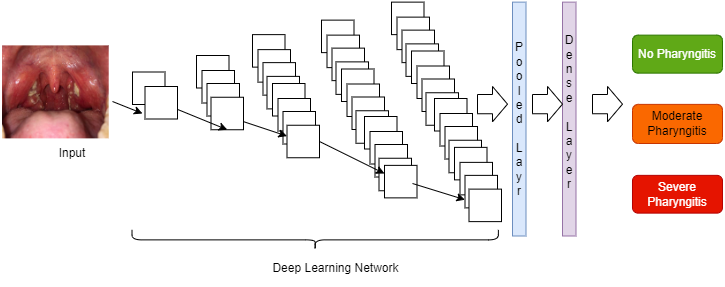Intelligent Early Diagnosis System against Strep Throat Infection Using Deep Neural Networks
Main Article Content
Abstract
The most frequent bacterial pathogen causing acute pharyngitis is Group-A hemolytic Streptococcus (GAS), and sore throat is the second most frequent acute infection. The immunological reaction to group A Streptococcus-induced pharyngitis results in Acute Rheumatic Fever (ARF). A genetically vulnerable host for ARF is a streptococcal infection. ARF, which can affect various organs and cause irreparable valve damage and heart failure, is the antecedent to Rheumatic Heart Disease (RHD). RHD, in many countries is Cardiovascular Disease (CVD) refers to a range of conditions that affect the heart and blood vessels, including coronary artery disease, heart attack, heart failure, and stroke. It is important to note that while this approach has demonstrated promising results, further studies and validation are necessary to establish its clinical feasibility and reliability. Further research can also be done to evaluate the generalization of the model to larger and diverse patient populations. The results showed that using Image Synthesis-based augmentation improved the ROC-AUC scores compared to basic data augmentation. The proposed method could be a valuable tool for healthcare professionals to quickly and accurately diagnose strep throat, leading to timely treatment and improved patient outcomes. The experimental findings indicate that the suggested detection approach for strep throat has a high level of accuracy and effectiveness. The approach has an average sensitivity of 93.1%, average specificity of 96.7%, and an overall accuracy of 96.3%. The ROC-AUC of 0.989 suggests that the approach is effective at distinguishing between positive and negative cases of strep throat. These results indicate that the suggested detection approach is a promising tool for accurately identifying cases of strep throat.
Article Details
References
The Global Burden of Disease Study 2020 (GBD 2020).
Kang, G., Dong, X., Zheng, L. and Yang, Y., 2017. Patchshuffle regularization. arXiv preprint arXiv:1707.07103.
Antony Kumar, K. and Carmel Mary Belinda, M.J., 2022. A Multi-Layer Acoustic Neural Network-Based Intelligent Early Diagnosis System for Rheumatic Heart Disease. International Journal of Image and Graphics, (p.2450012).
Cai, J., Xing, F., Batra, A., Liu, F., Walter, G.A., Vandenborne, K. and Yang, L., 2019. Texture analysis for muscular dystrophy classification in MRI with improved class activation mapping. Pattern recognition, Vol.86, (pp.368-375).
Lakhani, P. and Sundaram, B., 2017. Deep learning at chest radiography: automated classification of pulmonary tuberculosis by using convolutional neural networks. Radiology, 284(2), (pp.574-582).
R. Rulaningtyas, A. Suksmono, and T. Mengko., (2011). “Automatic classification of tuberculosis bacteria using neural network,” International Conference on Electrical Engineering and Informatics.
David, S. A., S. Ravikumar, and K. A. Kumar. 2018. “Lossless MRI Compression Utilizing Prediction by Partial Approximate Matching.” International Journal of Engineering and Technology (UAE) Vol.7, (pp.115–17).
Frid-Adar, M., Klang, E., Amitai, M., Goldberger, J. and Greenspan, H., 2018. Gan-based data augmentation for improved liver lesion classification.
Cubuk, E.D., Zoph, B., Mane, D., Vasudevan, V. and Le, Q.V., 2018. Autoaugment: Learning augmentation policies from data. arXiv preprint arXiv, (p.1805.09501).
Ravikumar, S. and Kannan, E., 2022. Analysis on Mental Stress of Professionals and Pregnant Women Using Machine Learning Techniques. International Journal of Image and Graphics, (p.2350038)
John S. Chorba, Avi M. Shapiro,Le Le., 2021. “Deep Learning Algorithm for Automated Cardiac Murmur Detection via a Digital Stethoscope Platform”, Journal of the American Heart Association. Vol.10, (p.019905).
He K, Gkioxari G, Dollár P, et al. Mask r-cnn[C]//Proceedings of the IEEE international conference on computer visi on. 2017: 2961-2969.
Sharma, Sumit, and Mahesh Parmar., 2020. "Heart diseases prediction using deep learning neural network model." International Journal of Innovative Technology and Exploring Engineering (IJITEE) Vol.9.3.
Pious, I.K., Kumar, K.A., Soulwin, Y.C. and Reddy, E.N., 2022, July. Heart Disease Prediction Using Machine Learning Algorithms. In 2022 International Conference on Innovative Computing, Intelligent Communication and Smart Electrical Systems (ICSES) (pp. 1-6). IEEE.
Manivannan, D. and Kavitha, M., 2022, January. Discovering Cardiovascular infection of Diabetics through Machine Learning Using Physionet bank. In 2022 International Conference on Advances in Computing, Communication and Applied Informatics (ACCAI) (pp. 1-7). IEEE.

